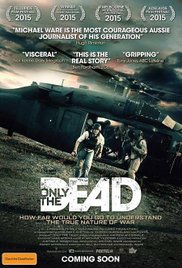
ONLY THE DEAD
Australia, 2015, 75 minutes, Colour.
Directed by Bill Guttentag and Michael Ware.
Produced and released in the context of IS in 2015, this film has an added dimension to its portrayal of events and warfare in Iraq, 2003 to 2007.
In some ways, what is seen on the screen is quite familiar to movie audiences who have looked at films about the Iraq war, including Paul Haggis’ In the Valley of Elah, Brian de Palma’s Rendition and, especially, Clint Eastwood’s American Sniper. In fact, the detailed movie recreations of warfare, the portrait of the soldiers, especially the snipers, and the picture of Iraqi insurgents as well as of ordinary people, have brought home a lot of the realities of war visually and aurally.
Which enhances watching Only The Dead in the light of these movies. This is the real thing.
Michael Ware, an Australian (and Screen Australia and Screen Queensland have contributed to this production), a journalist for Time Magazine, eager to be out in the field, chasing stories which gave him energy as well his reputation, was in Iraq just before the coalition invasion. He introduces himself, his background, his journalistic work, his camera continually with him, as well as his Russian colleague, Rudy, and the number of locals who helped the journalists in the Time office – and some regrets that the death of some of them.
He is near the Iraqi border in 2003, is with soldiers, experiences bombardments, and hears the news of the coalition attack. There are visuals of the bombing of Baghdad as well as speeches by President Bush.
In the aftermath of the attack, Michael Ware experiences brutality, roadside bombs and their consequences, which changes his perspective. He continues to accompany American soldiers in the field, filming them in action, shooting and explosions, woundings (including the word terrorist who takes a long time to die, many spasms until his expiring, their killings, as well as their views on patriotism to camera, the hardening of their attitudes towards the enemy.
But, he is approached by followers of the Jordanian-born terrorist, Al- Zarqawi, who was fomenting civil unrest, Civil War and insurgent uprisings in the immediate aftermath of the invasion.Michael Ware was brought into camps, met and filmed a number of the insurgents, recorded their attitudes, their patriotism, their anti-Americanism.
Al-Zaqawi? became one of the America’s most wanted, and Michael Ware served something of a pipeline between sides, puzzled why he was chosen, prepared to go into very risky situations, documenting the attacks and gruesome car bombings which began to increase.
His footage also shows many of the locals, some of whom were armed and possible terrorists, others who were caught in difficult circumstances, others who helped, and others who experienced devastation while innocent.
Towards the end of the film, a bombing raid, two heavy bombs, killed Al- Zarqawi – and he includes footage of television news programs from around the world announcing the death, including a triumphant George Bush.
While Michael Ware was to continue for some years working in Iraq, it was only much later that he assembled his footage, 300 hours taken over the years and decided that there was a story to tell, a story which highlighted in retrospect what happened during those years, and edited the material and wrote a narrative which he delivers.
The film won Australian Film Institute awards for editing, sound, direction.
On the one hand, the Hollywood movies have been able to recreate the battles in Iraq and this has made an impact – but, as we watch this film, sometimes with some horror, this is a record of the real thing, of actual events, warfare, deaths.